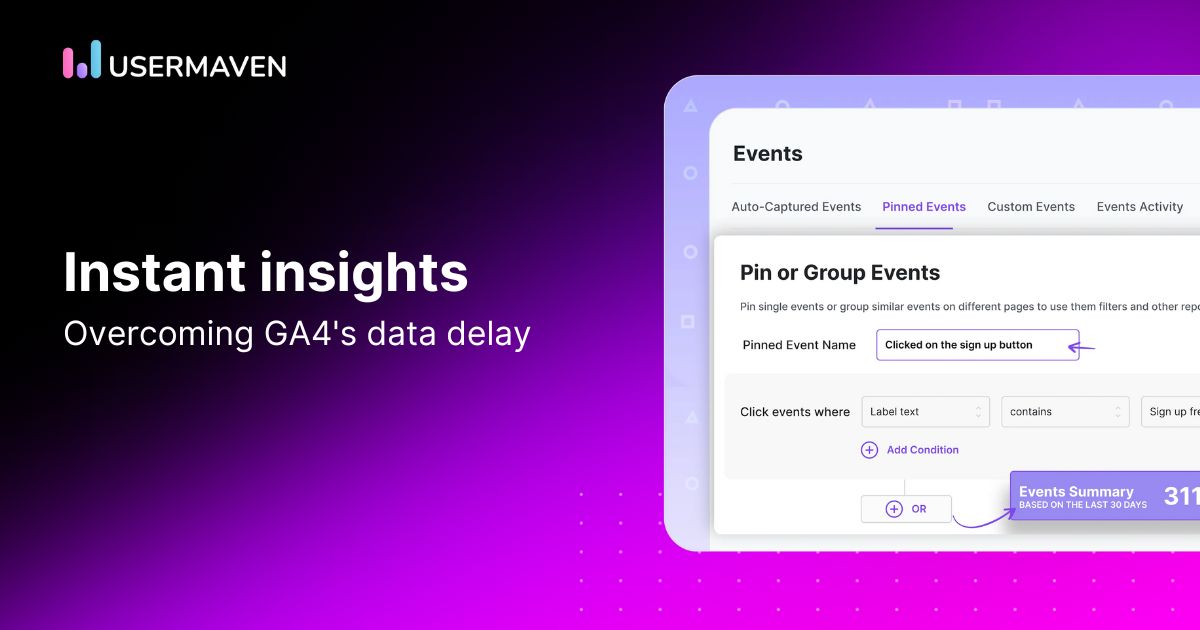Google Analytics (GA4) is a widely used tool by marketers, analysts, and website owners to track and analyze data on their websites. However, with GA4’s rollout came delays in reporting data that could slow down decision-making.
The delay in GA4 means it takes longer – between 24-72 hours – for the analytics reports to show information. This change from Universal Analytics or UA’s real-time reporting has left many feeling frustrated as they depend on quick data access to craft marketing strategies.
Usermaven addresses these shortcomings with real-time event tracking and instant analytics. By providing immediate insights, Usermaven empowers businesses to optimize their strategies and drive growth without the delays that plague GA4.
This blog post delves into the causes and implications of GA4’s reporting lag and introduces a powerful alternative for real-time event analysis.
GA4 data delay challenges: Causes and limitations
1. Complex data processing pipeline
GA4’s data delay primarily stems from its sophisticated data processing system. Unlike its predecessor, GA4 uses a more complex event-based data model that requires additional time to collect, process, and aggregate information from various sources.
- Data collection: GA4 gathers data from multiple touchpoints, including websites, mobile apps, and offline sources.
- Data processing: The collected data undergoes several processing stages, including filtering, transformation, and aggregation.
- Machine learning: GA4 applies machine learning algorithms to provide advanced insights, which adds to the processing time.
This multi-step process results in a delay ranging from 24 to 72 hours before data appears in reports.
2. Offline event storage impact
GA4’s ability to store offline events introduces additional complexity and potential delays:
- Local storage: When a device is offline, GA4 stores event data locally.
- Delayed transmission: Once the device reconnects, it sends the stored data to GA4 servers.
- Processing backlog: This can create a backlog of data to be processed, further extending delays.
3. Limitations in real-time reporting
While GA4 offers a real-time reporting feature, it has several limitations:
- Incomplete data: Real-time reports may not include all events due to processing delays.
- Limited metrics: Only a subset of metrics is available in real-time.
- Sampling: Real-time data may be sampled, potentially leading to inaccuracies.
4. Impact on custom dimensions and metrics
Custom dimensions and metrics in GA4 are subject to the same processing delays as standard events. This means that data for these custom attributes might not be immediately available for analysis. As a result, relying on custom dimensions and metrics for real-time or near-real-time insights can be challenging.
Impact of GA4 data delays
These delays have significant implications for businesses across various aspects of their operations:
1. Delayed decision-making:
- Critical business decisions may be based on outdated information, leading to missed opportunities or misaligned strategies.
- Rapid market changes or emerging trends might not be reflected in the data, causing businesses to react too late.
- Time-sensitive offers or promotions may be ineffectively timed due to lagging data on user behavior.
2. Campaign optimization challenges:
- Real-time campaign adjustments become nearly impossible, resulting in wasted ad spend on underperforming campaigns.
- A/B testing becomes less effective as results are not immediately available, prolonging the optimization process.
- Seasonal or event-based campaigns may conclude before their full impact can be assessed, hindering future planning.
3. User experience blind spots:
- Immediate issues affecting user experience may go unnoticed for days, potentially leading to increased bounce rates and lost conversions.
- Technical problems or bugs on the website might persist longer, negatively impacting user satisfaction and brand perception.
- Opportunities to enhance user engagement through timely content or feature adjustments may be missed.
4. Incomplete insights:
- Analyses based on partial data can lead to misguided strategies and incorrect conclusions about user behavior.
- Segmentation and cohort analysis may be less accurate as the full picture of user interactions is not immediately available.
- Attribution models may be skewed, leading to incorrect allocation of marketing resources.
5. Competitive disadvantage:
- Businesses relying solely on GA4 may fall behind competitors using real-time analytics solutions in terms of agility and responsiveness.
- Inability to quickly capitalize on market trends or competitor actions due to delayed data insights.
- Reduced ability to provide personalized, timely experiences to users compared to competitors with real-time capabilities.
6. Revenue impact:
- Delayed recognition of high-value user segments or profitable traffic sources may result in missed revenue opportunities.
- Slow response to cart abandonment or checkout issues can lead to significant losses in e-commerce environments.
- Inability to quickly adjust pricing or promotional strategies based on real-time demand and competition.
7. Resource allocation inefficiencies:
- Teams may waste time analyzing outdated data, reducing overall productivity.
- Development resources might be misallocated due to a lack of immediate feedback on feature usage or performance.
- Marketing budgets could be inefficiently distributed across channels due to delayed performance metrics.
8. Compliance and risk management challenges:
- Delayed data can hinder rapid response to potential data privacy issues or policy violations.
- Real-time fraud detection becomes more challenging, potentially exposing the business to increased risk.
- Compliance reporting may be based on incomplete data, potentially leading to inaccuracies in regulatory submissions.
9. Customer service limitations:
- Customer support teams may lack up-to-date information on user interactions, hindering their ability to provide timely and context-aware assistance.
- Proactive customer service based on real-time user behavior becomes difficult to implement.
10. Innovation constraints:
- The lag in data availability can slow down the iterative process of product development and innovation.
- Immediate feedback on new feature launches or updates is not available, potentially delaying critical improvements.
By understanding these comprehensive implications, businesses can better appreciate the need for real-time analytics solutions like Usermaven to complement or replace GA4 for time-sensitive decision-making and operations.
Also read: Why online privacy matters: Protect your personal data
Introducing Usermaven: A solution for real-time analytics
To overcome GA4’s data delay challenges, businesses need a more responsive and reliable solution. Usermaven is a cutting-edge, real-time event analysis platform designed to provide instant insights into user behavior and website performance.

Key advantages of Usermaven:
1. True real-time updates: Unlike GA4’s delayed reporting, Usermaven processes and displays all events in real time.
2. Instant decision-making: Make data-driven decisions based on up-to-the-second information.
3. Auto event tracking: Usermaven automatically tracks events happening on your website without any manual interpretation.
4. Custom event tracking: These events require manual configuration of tags for each specific event you want to track.
5. Improved campaign optimization: Adjust your marketing strategies on the fly with immediate feedback on campaign performance.
6. Enhanced user experience monitoring: Quickly identify and address issues affecting user satisfaction and conversion rates.
7. Competitive edge: Stay ahead of the curve with access to real-time insights that your competitors might be missing.
Related: Track events in Usermaven
End-note
While GA4 offers powerful analytics capabilities, its late events issue can significantly hinder businesses requiring real-time insights. By leveraging Usermaven’s real-time event analysis platform, marketers and website owners can overcome the limitations of GA4’s 72-hour latency period and make informed decisions based on the most current data available.
Don’t let delayed data hold your business back. Explore Usermaven today and experience the power of true real-time analytics, giving your business the agility and insight it needs to thrive in today’s fast-paced digital landscape.

FAQs
1. How does GA4’s data delay affect my ability to respond to security incidents or potential fraud?
GA4’s data delay can hinder your ability to respond to security incidents or fraud in real-time. Real-time analytics platforms like Usermaven offer immediate alerts for swift action.
2. How does real-time analytics impact my website’s performance compared to GA4?
Real-time analytics platforms like Usermaven are built to be lightweight, ensuring they do not slow down the website’s loading times or overall responsiveness.
3. How do late events in GA4 affect my data analysis?
Late events in GA4 can delay your data analysis by 24-72 hours, making it difficult to make timely decisions. Real-time analytics platforms like Usermaven provide immediate insights, ensuring your data is always up-to-date.

Leave a Reply